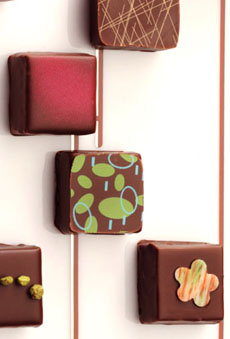 
These gorgeous bonbons from Jin Patisserie of Venice, California, a NIBBLE Top Pick Of The Week, bear zero resemblance to the chocolate first experienced by the Spanish Conquistadors. These: among the most delicious confections in America, are filled with fondant flavors like Ginger, Green Jasmine, Lemongrass and Roasted Black Sesame. The original chocolate was also exotic, but a bitter, unsweetened beverage mixed with pepper, chili pepper, musk, vanilla and cornmeal. It was enjoyed by the Aztecs but so unpalatable to the Europeans, they spat it on the ground.
|
KAREN HOCHMAN’s first word was not cacahuatl...but as her mother will attest, it was pretty close.
|
|
August 2005
Updated January 2009
|
 |
From Pod to Palate Part I: A Brief History Of Chocolate
Page 3: Chocolate Comes To Europe
This is Page 3 of a four-page article. Click on the black links below to visit other pages.
The Conquistadors: From Bitter to Bonanza
Chocolate Comes To Europe
The Spanish knew how to cook. They sweetened the chocolate beverage, first with honey and then with cane sugar. They replaced the Aztec spices with anise seed and orange blossom water, plus almonds or hazelnuts. They added cinnamon, cloves, egg yolks and Madeira. They used boiling water instead of cold water to create a hot drink. They served it with a side of fried bread. And chocolate was a huge hit, drunk night and day instead of water or wine.
Chocolate was so popular that the government decided to keep it as a pleasure of the rich and powerful by imposing very high taxes. They also kept a monopoly by prohibiting export (although by 1615 it had managed to migrate to France and Italy). In England, tea from China, coffee from Africa via the Middle East trade routes, and chocolate from South America arrived in seventeenth century Europe at roughly the same time, but chocolate remained costly and out of reach long after coffee and tea became affordable indulgences.
No wonder it took almost 150 years from the first arrival of the beans for the beverage to be transformed into a solid food. In until 1674 chocolate was made into both pudding and pastilles. London’s first chocolate shop (for drinking and socializing, like a tea salon) opened in 1657. Finally, chocolate could be experienced by people other than nobles.
With the industrial revolution of the latter 18th and early 19th centuries, chocolate became more accessible to everyman. The invention of labor-saving machines meant faster, cheaper production; there were inexpensive transportation and lower taxes. One labor-saver ground cacao nibs into paste. In Dorchester, Massachusetts, an Irish importer of cacao beans, John Hannon, and American, Dr. James Baker, built one of the first chocolate manufacturing plants to produce cakes of ground cacao bean paste for drinking chocolate. The first commercial eating chocolate was made and sold in blocks by François-Louis Cailler in 1819.
But solid chocolate was not yet the smooth, velvety confection that we know today. It had a rough flavor, although people developed a taste for it. It took more than 25 years for Dutch chemist Coenrad Van Houten and others to solve that problem. In 1828 Van Houten received a patent for his method of pressing about half the cocoa butter out of ground cacao nibs with hydraulic pressure, creating hard cakes called “dutch cocoa” which were pulverized into cocoa powder.* By adding alkali to reduce the acidity, he removed the roughness of natural chocolate. Cocoa powder enabled the quick preparation of beverages and easy combination with other ingredients. Van Houten mixed the cocoa butter with sugar and cocoa powder to create the first chocolate candies.
*History has been generous to Van Houten: He actually did not invent the first press, but was the first to patent it.
Continue To Page 4: The First Chocolate Bar
Go To The Article Index Above

|